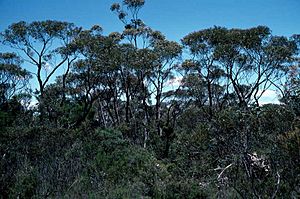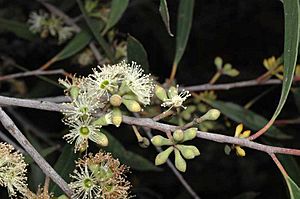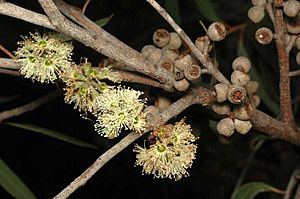Privet-leaved stringybark facts for kids
Quick facts for kids Privet-leaved stringybark |
|
|---|---|
 |
|
| Eucalyptus ligustrina on Kings Tableland | |
| Scientific classification | |
| Genus: |
Eucalyptus
|
| Species: |
ligustrina
|
The Privet-leaved stringybark (scientific name: Eucalyptus ligustrina) is a special type of shrub or small tree. It mostly grows in New South Wales, Australia. This plant gets its name "stringybark" because its bark is rough and looks like strings. It also has leaves that look a bit like those of a plant called Ligustrum, which is why it's called "privet-leaved."
This eucalyptus has unique features like its rough bark, long leaves, and white flowers. It produces small, round fruits after flowering. It is a plant that is endemic to New South Wales, meaning it is found only there.
Contents
What Does the Privet-leaved Stringybark Look Like?
The Privet-leaved stringybark is usually a small tree or a mallee, which means it has many stems growing from the ground. It can sometimes grow up to 20 meters tall, but it's often less than 10 meters. This plant has a special woody swelling at its base called a lignotuber. This helps it regrow after fires.
Bark and Leaves
The bark on its main trunk and bigger branches is rough and greyish-brown. It feels stringy, like loose fibers. On thinner branches, the bark is smooth.
Young plants and new shoots have egg-shaped leaves. These leaves are about 1 to 3.8 centimeters long and 0.7 to 2.2 centimeters wide. They have very short stems.
Adult leaves are shiny green on both sides. They can be lance-shaped, curved, or egg-shaped. These leaves are usually 3 to 10 centimeters long and 0.5 to 2 centimeters wide. They have a stem about 0.4 to 1 centimeter long.
Flowers and Fruit
The flowers of the Privet-leaved stringybark are white. They grow in groups of seven to fifteen. These groups are found where the leaves meet the stem. Each group sits on a small stalk about 0.4 to 0.6 centimeters long. The individual flower buds do not have their own stalks.
Mature buds are oval or club-shaped. They are about 0.3 to 0.5 centimeters long and 0.2 to 0.3 centimeters wide. Each bud has a cone-shaped or rounded cap. This cap protects the flower inside.
This eucalyptus usually flowers from April to May and again from September to October. After flowering, it produces woody fruits. These fruits are shaped like half-spheres or flattened spheres. They are about 0.3 to 0.6 centimeters long and 0.5 to 1 centimeter wide. The parts that open to release seeds are below the rim of the fruit.
How Was This Plant Named?
The scientific name for this plant, Eucalyptus ligustrina, was first officially described in 1828. A Swiss botanist named Augustin Pyramus de Candolle gave it this name. He wrote about it in his book Prodromus Systematis Naturalis Regni Vegetabilis.
The second part of its scientific name, ligustrina, comes from the word Ligustrum. This is a type of plant commonly known as privet. The botanist chose this name because the leaves of this eucalyptus look similar to the leaves of privet plants.
Where Does the Privet-leaved Stringybark Live?
The Privet-leaved stringybark grows in New South Wales, Australia. You can find it from the Gibraltar Range National Park in the north down to Deua National Park in the south. However, it is most common in the Blue Mountains area.
This plant prefers to live in dry sclerophyll woodland or heathland. These are types of forests or open areas with tough, leathery-leaved plants. It grows well in poor soils. These soils often come from sandstone or acidic granite rocks.



